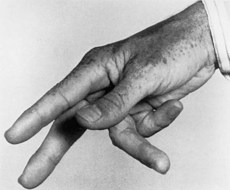141 Carpopedal spasm (post-thyroidectomy hypoparathyroidism)
Salient features
Examination
• Spasm of the hands: fingers are extended, except at the metacarpophalangeal joints, and the thumb is strongly adducted.
• Tell the examiner that you would like to perform the following tests:
Advanced-level questions
How would you manage an acute attack of hypoparathyroid tetany?
• Slow intravenous calcium gluconate and oral calcium
• Magnesium (if associated hypomagnesaemia)
• Outpatient therapy with calcium carbonate three times daily and calcitriol once or twice daily adjusting the dose to maintain a target level of albumin-corrected serum calcium at the lower end of the normal range (approximately 80–85 mg/l (2.00–2.12 mmol/l)), a 24-hour urinary calcium level of <300 mg, and a calcium–phosphate product <55.
What are the causes of hypoparathyroidism?
• Damage during thyroid or neck surgery (Lancet 1960;ii: 1432)
• Destruction of the parathyroid gland caused by the following:
• Dysembryogenesis (DiGeorge syndrome)
• Polyglandular autoimmune syndrome (PGA type 1), which is also known as autoimmune polyendocrinopathy–candidiasis–ectodermal dystrophy (APECD).
How is corrected total calcium calcuated?
Albumin-corrected total calcium is calculated as follows:
where calcium is measured in milligrams per decilitre and albumin is measured in grams per decilitre.
What is the mechanism of hypocalcaemia?
Hypocalaemia results from PTH secretion that is inadequate to:
What are the main physiological effects of parathyroid hormone?
It results in a net increase of ionized calcium in the plasma through:
• increased bone osteoclastic activity, resulting in increased delivery of calcium and phosphorous to the extracellular compartment
• enhanced renal tubular absorption of calcium
• inhibited absorption of phosphate and bicarbonate by the renal tubule
• stimulated synthesis of 1,25-dihydrovitamin D by the kidney.









